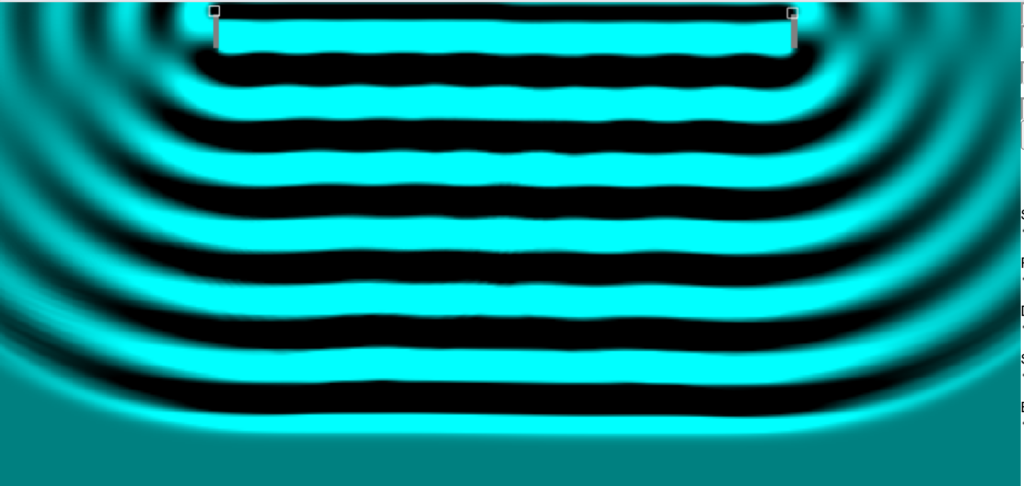I’m not teaching any more, but I don’t want to just bin a decade worth’s of lecture notes, so here’s part of the first lecture tech students get in their first week of university:
To talk about sound, we must first talk about air. This is made up of about 78% nitrogen, 21% oxygen and various other gases. At 20 degrees Celsius (that is, room temperature), each air molecule is moving all the time at 500 metres per second. They are constantly colliding with each other and with anything in their path.
If a football hit you at 500 m/s, you’d be in trouble, but air molecules are tiny. Force = mass* acceleration. The force of a football is huge in comparison to a single nitrogen atom. But if you pump a lot of air into a tyre, say 6 bar (87 psi), the force of all the colliding air molecules will make the tyre very stiff. At sea level, the pressure of the atmosphere is about 1.03 bars (14.7 psi).
So how does sound propagate in air? Let’s say Adam Kryński hits his Bodhrán with a stick.

This causes the drum membrane to move very suddenly. He pushes the membrane and, on the other side of the drum, the membrane pushes on all the air molecules. They get packed in together. This creates a band of high pressure, that starts at the drum and moves outwards. All the molecules are moving at 500 m/s. But they’re not all going in the same direction. Some are going away from the drum, but some are going sideways or backwards. They’re all crowded though, and colliding into the molecules around them, so that wave of intense collisions, the high pressure wave, is moving away from the drum at 340 m/s, at room temperature.
If we were in Death Valley when it was 20 degrees out, the air pressure would be higher, so there would be more collisions. However, the air molecules would still be moving at their normal speed, so the pressure wave would still move at 340 m/s. If we were on Mount Everest at 20 degrees, there would be fewer collisions, but the speed would still be the same.
However, at 30 degrees, air moves faster, so sound moves faster. And at 10 degrees, air is slower so sound is slower.
Kryński’s drum head has creates a high pressure wave when it moved from being hit, but it doesn’t stay in that position. The drum head snaps back in the other direction, passing it’s mid point. This movement backwards creates a space where there are fewer air molecules. A low pressure wave follows the high one, moving at the same speed.
The head, still out of place snaps back forwards again, creating another, smaller, pressure wave and then another smaller wave of low pressure.
We can see a simulation of this drum head via Falstad.

You can see the high and low pressure waves. In this simulation, the drum head vibrates forever, but it does give you an idea of the sound waves moving away from the drum.
These sound waves might reach your ear. But what is the amount of pressure change that your ear is actually perceiving? At sea level, the pressure of the atmosphere is 101.3 kilo pascals. The pressure change created by sound waves is in micro pascals, a tiny amount. It’s possible for air pressure to vary by more than that. A 1% change in pressure travelling at the speed of sound is, essentially, an explosion that can knock over a building. Atmospheric pressure, such as high and low pressure fronts you hear about in the weather forecast, has big variances relative to sound, but these changes happen very slowly.

@celesteh The Physics of The Bodhrán.
#Science #Music #MastoDaoine
Remote Reply
Original Comment URL
Your Profile
It’s a massive over-simplification. I picked and open backed drum so I could start with a pressure wave. When I presented this to students, I hit a table and talked about what happened with that. Of course, the table top first creates a low pressure wave, which seemed a lot to talk around for a blog post.
@fredrik wallberg Interesting way to explain speed of sound and the Doppler effect.
Remote Reply
Original Comment URL
Your Profile
The doppler effect isn’t actually mentioned in this post, but if you have a moving sound source, it’s throwing off high and low pressure waves, but it’s also moving towards them in one direction, so those are going to be squished together, whereas, it’s moving away from the waves in the other direction, so they’re going to be more spread out. If you go to falstad, you can create simulations of moving sound sources that show this.